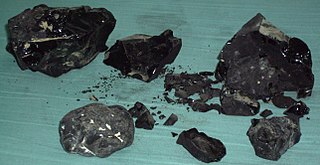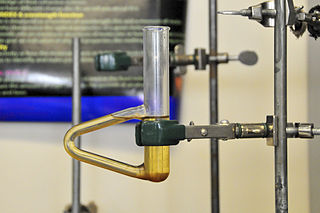Related Research Articles

Asphalt, also known as bitumen, is a sticky, black, highly viscous liquid or semi-solid form of petroleum. It may be found in natural deposits or may be a refined product, and is classed as a pitch. Before the 20th century, the term asphaltum was also used. The word is derived from the Ancient Greek ἄσφαλτος ásphaltos. The largest natural deposit of asphalt in the world, estimated to contain 10 million tons, is the Pitch Lake located in La Brea in southwest Trinidad, within the Siparia Regional Corporation.

Raclette is a Swiss and Savoyard dish, also popular in the other Alpine countries, based on heating cheese and scraping off the melted part, then typically served with boiled potatoes. Raclette cheese is a Swiss-type cheese marketed specifically to be used for this dish, a notable product being the (AOP) Raclette du Valais.
Tarmacadam is a road surfacing material made by combining crushed stone, tar, and sand, patented by Welsh inventor Edgar Purnell Hooley in 1902. It is a more durable and dust-free enhancement of simple compacted stone macadam surfaces invented by Scottish engineer John Loudon McAdam in the early 1800s.

A road surface, or pavement, is the durable surface material laid down on an area intended to sustain vehicular or foot traffic, such as a road or walkway. In the past, gravel road surfaces, cobblestone and granite setts were extensively used, but these have mostly been replaced by asphalt or concrete laid on a compacted base course. Asphalt mixtures have been used in pavement construction since the beginning of the 20th century and are of two types: metalled (hard-surfaced) and unmetalled roads. Metalled roadways are made to sustain vehicular load and so are usually made on frequently used roads. Unmetalled roads, also known as gravel roads, are rough and can sustain less weight. Road surfaces are frequently marked to guide traffic.

Asphalt concrete is a composite material commonly used to surface roads, parking lots, airports, and the core of embankment dams. Asphalt mixtures have been used in pavement construction since the beginning of the twentieth century. It consists of mineral aggregate bound together with asphalt, laid in layers, and compacted. The process was refined and enhanced by Belgian-American inventor Edward De Smedt.

Plastic welding is welding for semi-finished plastic materials, and is described in ISO 472 as a process of uniting softened surfaces of materials, generally with the aid of heat. Welding of thermoplastics is accomplished in three sequential stages, namely surface preparation, application of heat and pressure, and cooling. Numerous welding methods have been developed for the joining of semi-finished plastic materials. Based on the mechanism of heat generation at the welding interface, welding methods for thermoplastics can be classified as external and internal heating methods, as shown in Fig 1.

A flat roof is a roof which is almost level in contrast to the many types of sloped roofs. The slope of a roof is properly known as its pitch and flat roofs have up to approximately 10°. Flat roofs are an ancient form mostly used in arid climates and allow the roof space to be used as a living space or a living roof. Flat roofs, or "low-slope" roofs, are also commonly found on commercial buildings throughout the world. The National Roofing Contractors Association defines a low-slope roof as having a slope of 3 in 12 (1:4) or less.

Julius Richard Petri was a German microbiologist who is generally credited with inventing the device known as the Petri dish, which is named after him, while working as assistant to bacteriologist Robert Koch.
In analytical chemistry, ashing or ash content determination is the process of mineralization for preconcentration of trace substances prior to a chemical analysis, such as chromatography, or optical analysis, such as spectroscopy.

A foundry is a factory that produces metal castings. Metals are cast into shapes by melting them into a liquid, pouring the metal into a mold, and removing the mold material after the metal has solidified as it cools. The most common metals processed are aluminum and cast iron. However, other metals, such as bronze, brass, steel, magnesium, and zinc, are also used to produce castings in foundries. In this process, parts of desired shapes and sizes can be formed.

A countertop, also counter top, counter, benchtop, worktop or kitchen bench, is a raised, firm, flat, and horizontal surface. They are built for work in kitchens or other food preparation areas, bathrooms or lavatories, and workrooms in general. The surface is frequently installed upon and supported by cabinets, positioned at an ergonomic height for the user and the particular task for which it is designed. A countertop may be constructed of various materials with different attributes of functionality, durability and aesthetics, and may have built-in appliances, or accessory items relative to the intended application.

Damp proofing or a Damp-Proof in construction is a type of moisture control applied to building walls and floors to prevent moisture from passing into the interior spaces. Dampness problems are among the most frequent problems encountered in residences.

The Thiele tube, named after the German chemist Johannes Thiele, is a laboratory glassware designed to contain and heat an oil bath. Such a setup is commonly used in the determination of the melting point of a substance. The apparatus itself resembles a glass test tube with an attached handle.

A melting-point apparatus is a scientific instrument used to determine the melting point of a substance. Some types of melting-point apparatuses include the Thiele tube, Fisher-Johns apparatus, Gallenkamp (Electronic) melting-point apparatus and automatic melting-point apparatus.
The softening point is the temperature at which a material softens beyond some arbitrary softness. It can be determined, for example, by the Vicat method, Heat Deflection Test (ASTM-D648) or a ring and ball method. A ring and ball apparatus can also be used for the determination of softening point of bituminous materials.
There are a number of possible ways to measure thermal conductivity, each of them suitable for a limited range of materials, depending on the thermal properties and the medium temperature. Three classes of methods exist to measure the thermal conductivity of a sample: steady-state, time-domain, and frequency-domain methods.
Reflux is a technique involving the condensation of vapors and the return of this condensate to the system from which it originated. It is used in industrial and laboratory distillations. It is also used in chemistry to supply energy to reactions over a long period of time.

The piston-cylinder apparatus is a solid media device, used in Geosciences and Material Sciences, for generating simultaneously high pressure and temperature. Modifications of the normal set-up can push these limits to even higher pressures and temperatures. A particular type of piston-cylinder, called Griggs apparatus, is also able to add a deviatoric stress on the sample.
The principle of the instrument is to generate pressure by compressing a sample assembly, which includes a resistance furnace, inside a pressure vessel. Controlled high temperature is generated by applying a regulated voltage to the furnace and monitoring the temperature with a thermocouple. The pressure vessel is a cylinder that is closed at one end by a rigid plate with a small hole for the thermocouple to pass through. A piston is advanced into the cylinder at the other hand.
References
- ↑ "When does tarmac melt?". BBC News. 2013-07-15. Retrieved 2020-04-17.
- ↑ "Right Grade of Bitumen for Flexible Pavements: Indian Perspective". www.nbmcw.com. Retrieved 2020-04-17.
- ↑ "CFR - Code of Federal Regulations Title 21". www.accessdata.fda.gov. Retrieved 2020-04-17.
- ↑ US 7847011,Kitson, Ralph P.,"Intermediate softening point resin-based hot melt PSAs",published 2010-12-07, assigned to Avery Dennison Corp.
- ↑ "Ring and ball test apparatus for Softening Point of Bituminous material. Cement Concrete". Cement Concrete. 2019-08-16. Retrieved 2020-04-17.
- ↑ Walker, P. H. (1930). The ring and ball method of test for softening point of bituminous materials, resins, and similar substances. NIST Research Library. National Bureau of Standards.